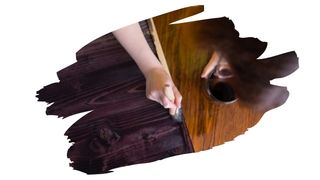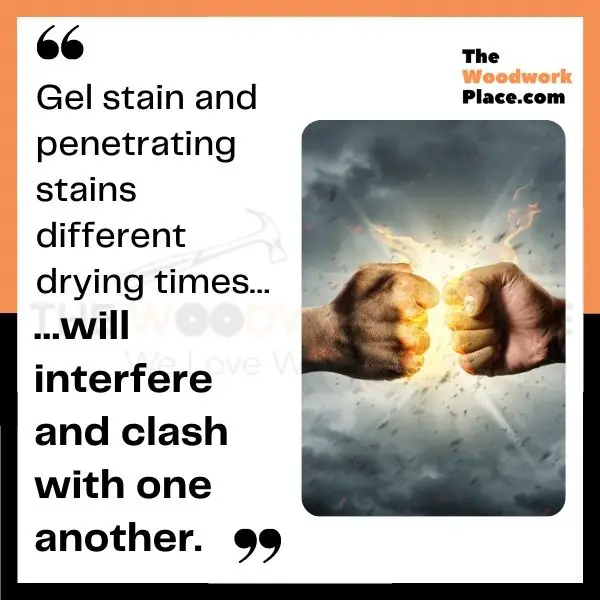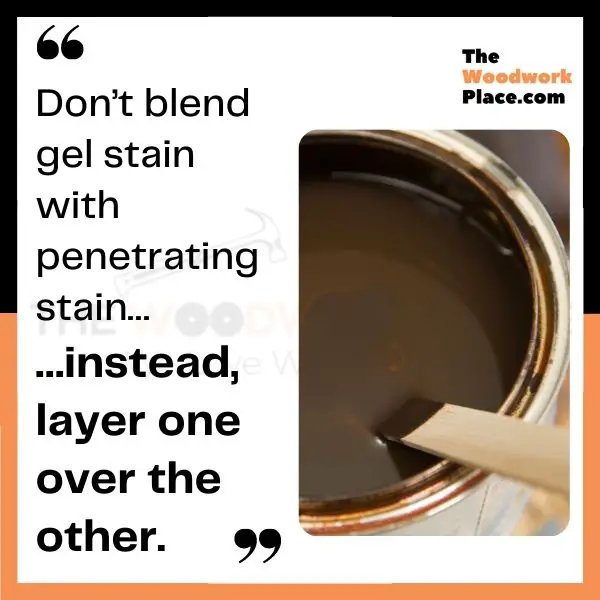Are you struggling to find wood stain that’s just the right color for your furniture?
Or maybe you’ve already applied a penetrating wood stain. And yet, sections of that stained surface aren’t quite dark enough.
If this is the case, then it makes perfect sense to go the route of blending two different stains together.
Blending two wood stains is simple enough. In fact, this is a great way to make your own customized tinted penetrating stain.
But, what about when it comes to mixing two different types of stain product altogether? Could you maybe try blending a penetrating stain with a gel stain?
Related Post: Can You Put Polyurethane Over Gel Stain? (Best Practice Revealed!)
Well, in this post, you will learn why an oil-based stain should rarely be mixed with a solvent-based gel stain. And you will also find out why layering these two stain products beats out trying to blend them (every single time).

This post may contain affiliate links to products that we receive a commission for (at no additional cost to you). Learn more here.
Why Isn’t My Wood Stain Dark Enough? Will More Coats Fix This?
Stain works by soaking into wood pores, and attaching tinted pigment to wood fibers.
It attaches this pigment using a binding agent. For example, varnish is used as a binding agent in a lot of oil-based wood stain products.
Now, varnish will not only bind pigment, it will also seal over wood pores too. This means your first coat of wood stain will be the one doing most of the heavy lifting when it comes to coloring wood.
But, once that first coat dries, each subsequent coat of wood stain won’t be able to penetrate wood as deeply (or even at all).
Anything more than 2 or 3 stain coats isn’t going to further deepen the color of wood (any more than that stain already has).
So, if you want to darken wood stain further, you may need to look into applying a gel stain over it.
Can You Put Regular Penetrating Stain Over Gel Stain? No, you can’t. Penetrating stain needs to sink into wood to work properly. And a gel stain coat will have sealed over that grain, preventing regular stain from being absorbed.
What Is The Difference Between Gel Stain And Penetrating Stain?
Penetrating stains work by soaking into lumber. Gel stain, on the other hand, works by ‘painting’ over a timber surface.
Basically, regular stain sinks into wood, while gel stain sits on the surface. Yet, the real difference between them is more visual.
A penetrating stain won’t hide any of that beautiful natural wood grain. While a gel stain can coat and mask much of the texture of wooden surfaces.

Will These Two Stains Blend? Can Mixing Oil Stain With Gel Stain Work Out?
Well, oil based stains are made from a mix of coloring pigments, and varnish. While gel stains are solvent-based products, and they contain ingredients such as mineral spirits and naphtha.
Related Post: Can You Mix Linseed Oil With Mineral Spirits? [Best Practice Revealed!]
As a solvent-based stain, gel stain will blend into oil-based stain, and will thin out that oily stain a lot. Regardless, these two differing products will blend together.
Mixing These Stains Isn’t The Problem…Drying Times Are The Real Issue
Getting these two products to blend together isn’t your real problem. The real issue is that gel stain and penetrating stains both dry at completely different rates.
When you blend two completely different finishes, (each one drying at their own rate), you end up with a finish that looks cloudy.
What Happens When A Wood Stain Coat Begins To Dry?
When we say that a wood stain is drying, we are referring to an evaporation process.
This means that the water (in water-based stain) or solvents (in oil-based/solvent stain) will begin to vaporize at room temperature.
And once this evaporation process is complete, what gets left behind is a coat of solid color.
But, Inconsistent Drying Equals Cloudy Finishes
A cloudy (almost milky) looking finish is the result of moisture getting trapped underneath a finishing coat that is still in the process of drying.
This cloudy looking result is what we refer to in the industry as ‘blushing’. And it frequently happens to freshly applied finishes that have been left to dry in very humid conditions.
So, the problem with blending gel stain and penetrating stain together, is that their drying rates are very different. Wood stain can dry in as little as 6 hours. While gel stain needs around 24 to 48 hours to dry.
If you mix these two products together, you’ll end up with one product ‘trapping’ the evaporating vapor of the other.
Basically, the drying process of gel stain will interfere with the drying process of oil-based (or water-based) stain. And vice versa.
Related Post: Gel Stain Not Drying? (Learn How To Fix This Common Gel Stain Problem)

Don’t Mix Gel Stain Into Penetrating Stain… Layer Gel Stain Over It
Layering is a much better way to get the color consistency you want, without needing to blend these stains together. By layering, you give both gel stain and oil stain a chance to dry at their own pace:
- 1). Before you start, test out stain layering on a piece of scrap wood. If you like how it turns out, you can apply the same stain layering onto your main piece.
- 2). Just remember to always apply penetrating wood stain first (so that it can soak evenly into that lumber).
- 3). Wipe off any excess penetrating stain using a dry lint-free cloth. This is key to making sure stain dries evenly.
- 4). Always wait for penetrating stain to properly dry through before applying gel stain. This can take as little as 6 hours. But, waiting 24 hours is best practice.
- 5). Afterwards, you can layer on those gel stain coats.
To Wrap Up, Here Are The 3 Key Takeaways From This Post…
- 1). Gel stain and penetrating stains different drying times will interfere with one another.
- 2). Don’t blend gel stain with penetrating stain. Instead, layer one over the other.
- 3). And always make sure you apply the penetrating stain layer first, and the gel stain afterward.

![Will Tacky Wood Stain Eventually Dry? [What To Do When Stain Is Not Drying] will tacky stain eventually dry](https://www.thewoodworkplace.com/wp-content/uploads/2022/10/Banner-502-150x150.jpg)

